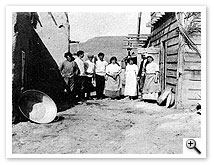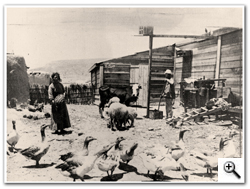|
Degania A, Mother of the Kibbutzim, was established in 1910. Thoughts of communal
settlement and communes permeated the intellectual atmosphere of Europe at the end
of the 19th and beginning of the 20th century. The word kevutsa (collective farmstead)
was uttered for the first time at the Kinneret farm, established in 1909 by the Land of
Israel Office headed by Dr. Arther Ruppin. This was during the period of the Second
Aliya (1904-1914) when the Ottoman Empire ruled the country.
Some of the First Aliya settlements were successful, others were on the decline.
The young Jewish immigrants coming from Europe, as individuals or in small groups,
were inspired by Socialist and Zionist ideals: to create a new, just Jewish society in
the Land of Israel. These young people wandered among the old settlements, seeking
a livelihood as day laborers while developing a vision of Zionism and progress. One of the
ways to create this new, just Jewish society was by establishing a communal way of life,
a commune.
 In 1907 the Zionist Federation established the "Land of Israel Office" and appointed
Dr.Arthur Ruppin as its director, who immediately began the purchasing of land.
The first bloc of land, Umm J'uni and Deleika (southwest of the Sea of Galilee) was
purchased from the J.C.A. (the Jewish Colonization Association founded by Baron
Maurice de Hirsh) which had no interest in this land. Ruppin also established the
"Kinneret Farm" for the training of agricultural workers, under the professional
supervision of an agronomist. The farm, however, encountered management problems.
A solution was found in a suggestion whereby a group of workers would receive a
tract of land on which, under their own self management, they would grow field crops
for one year. At the end of his year profitability would be assessed.
|

|

|
|
Between the hut and the
shack, Umm-J'uni 1910 |
Umm-J'uni 1911 |
At the Kinneret Farm several ideas and social ideals of a workers' movement
blossomed and came to fruition. Many workers and training groups from the Second Aliya
passed through this farm up to the establishment of the State of Israel in 1949.
One of the first to come was a small group of people originating from the town
of Romni in White Russia and was known as the "Romnian Commune"; One of the
members of this group, was Joseph Bussel. It was on the Kinneret Farm that Bussel
had begun to formulate the idea of the Communal Farmstead. in the wake of the feud
with the farm manager, Ruppin fired the workers as well as the manager; Bussel and
his friends then left the Kinneret farm for Hadera and while expending the group came
to be known as the "Hadera Commune".
|
|
|
The "Hadera Commune" 1910
before going to Umm-J'uni |
Ruppin was listening to the pioneers ideas and respect them, so while firing them he
invited a chosen group of workers, representing all of the socialist parties that gathered
from all over the Galilee and settled them near the village of Umm J'uni as independent
party. They were called the "conquest group" and in 1910 they succeeded in tilling the
fields. After a year of successful farming and showing profite, the "conquest group"
dispersed. This was the proof Ruppin needed to justify inviting the "Hadera Commune"
to come and settle at Umm Juni. The "Hadera Commune" was called back to the
Kinneret Farm to assume the place of the "conquest group" and settle at Umm J'uni.
Joseph Bussel was one of the central figures in this group. After a fervent debate
between continuing in a wake of other group or establishing a new one, they decided
to accepet Rupin offer to settle in Umm J'uni.
|
|
|
The contract with the Hadera Commune |
At the end of 1910 the members of the "Hadera Commune" crossed the Jordan River
on an assignment for the Land of Israel Office, under the direction of Dr. Arthur Ruppin,
and they camped at Umm J'uni, south of the Sea of Galilee.
And so they wrote:
on the 25th of Tishrei 5671 (October 28th 1910) "We have arrived, ten men and two
women, to receive the inventory from the "labor conquest group". We have
proceeded to establish an independent settlement of Jewish workers in the
national homeland - a Commune."
Tzvi Yehuda Zaltsman, Chaim Tzadikov, Yehoshua Ecker, Aharon Yosilevitch and
Tzvi Lichtenstein-Tamari and Ya’akov Apter.
|
|
|
|
Umm-J'uni, the main shed 1911 |
Joseph Baratz - Umm J'uni |
The will to revive the people in the Land of Israel as a working people, returning to nature
and to the tilling of the land, living from the fruits of its own labor with neither exploiters
nor exploited, brought them to recognize that this could only be realized through
communal living.About 3,000 dunams of the Umm J'uni land that were purchased by
the “Hachsharat Hayishuv” company for the "Jewish National Fund", was given to the
group to tille.The Haifa-Tzemach-Damascus railroad track crossed the edge of the area
on its eastern perimeter, near the Arab village of Semak. The southern part of the
Kinneret and the Jordan, which emerges from the Kinneret on its way down to the
Dead Sea, are the northern and western border of this area.
|
|
|
|
Establishing Degania 1912 |
Establishing Degania 1912 |
On the 12th of Ab 5671 (August 6th 1911) Joseph Bussel, who already stood out as
the eminent figure of the commune, sent a telegram:
" To the director of the Land of Israel Office, Dr. Arthur Ruppin.
Dear Sir,
We hereby inform your honor that we have named our new settlement
‘Degania’, after the five varieties of grains growing here".
The name was accepted and immediately became known to the entire land (Yishuv)
and within a year or two the name Umm-J'uni was forgotten”. On a day in Sivan 5672
(June 1912), during the harvest days between Pesach and the Shavuot holidays, the
group moved from the mud huts and shack of Umm-Juni to its new buildings at
Bab-el-Tom (in Arabic- The River Gate), where the Jordan emerges from the Kinneret
which today is Degania.
In 1960 at Degania 50 anniversary, the maim cowshed which was not fit to hold modern
machinery, was turned into a big modern gathering hall, and the grain store beside it
to be a member clubroom.
In the 1980’s the all enclosure of the first buildings of Degania was renovated, with its
two main buildings and the others as well. Today the buildings serve as a gathering
place – a clubroom, a library and study room, a museum, a memorial room, the archive and the community’s administration offices. The place was given the
name:Pioneers Yard.
החצר 1914
חצר ראשונים 2011 |

